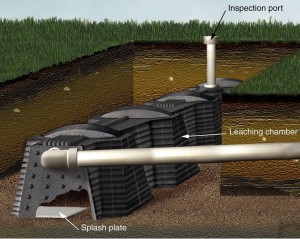 Leaching chamber systems handle wastewater in a similar manner as conventional gravel-filled drainfield systems. The main difference is in how the trench is constructed.
Leaching chamber systems handle wastewater in a similar manner as conventional gravel-filled drainfield systems. The main difference is in how the trench is constructed.
A leaching chamber system includes:
• A treatment device, generally a septic tank, but it can be an advanced pretreatment component.
• A leaching chamber, which is a commercially available plastic chamber molded into a dome shape. The chamber top is solid so that it can support the soil above it; the sides are louvered; and the bottom is open to allow the water to exit. Chamber widths vary from
15 to 36 inches.
• Leaching chamber trenches, which can be no longer than 150 feet.
In a leaching chamber system, a solid 4 inch diameter pipe carries wastewater from the septic tank to the leaching chamber trenches. The leaching chambers store the wastewater until it enters the soil. Each leaching chamber system should have at least one observation port to allow water levels in the trench to be inspected.
Related Resources:
 Leaching Chambers (and in Spanish)
Leaching Chambers (and in Spanish)